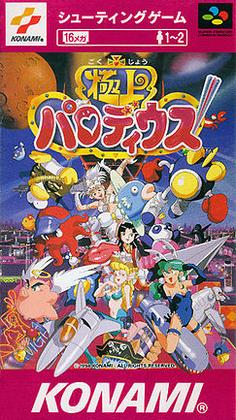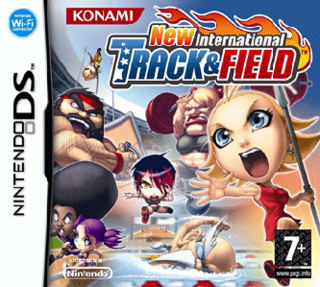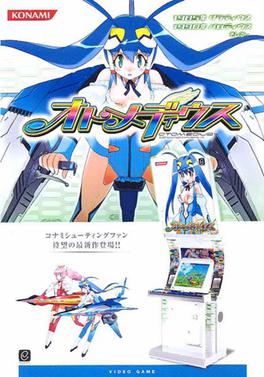TwinBee (ツインビー) is a video game series composed primarily of cartoon-themed vertical-scrolling shoot-'em-up games produced by Konami that were released primarily in Japan. The series originated as a coin-operated video game simply titled TwinBee in 1985, which was followed by several home versions and sequels. The character designs of almost every game in the series since Detana!! TwinBee in 1991 were provided by Japanese animator Shuzilow HA, who also planned and supervised most of the subsequent installments in the TwinBee series. The series also inspired a radio drama adaptation that lasted three seasons in Japan, as well as an anime adaptation.
Parodius is a series of cute 'em ups developed and published by Konami. The games are tongue-in-cheek parodies of Gradius, and also feature characters from many other Konami franchises.

Antarctic Adventure is a video game developed by Konami in 1983 for the MSX, and later for video game consoles, such as NES and ColecoVision. The player takes the role of an Antarctic penguin, racing to various research stations owned by different countries in Antarctica.

Konami Krazy Racers, known in Japan as Konami Wai Wai Racing Advance, is a kart racing video game published and developed by Konami for the Game Boy Advance handheld video game console. It was first released in Japan, and was later released in North America and some PAL regions. It was also re-released for Wii U Virtual Console on October 15, 2015 in Europe. It was a launch game for the system. Konami Krazy Racers makes use of a variety of characters and concepts from several of Konami's franchises, including Castlevania, Metal Gear, and Gradius. It plays similarly to the Mario Kart series, with eight characters per circuit and offensive/defensive items placed at predetermined points in the tracks.

Jikkyō Oshaberi Parodius is the fourth game in the Parodius franchise, a series of parody shooters produced by Konami. The gameplay is stylistically very similar to the Gradius series, but the graphics and music are intentionally absurd. The game contains a large number of Japanese voice samples shouted out in a style similar to that of a game show host. Unlike the previous two titles, Jikkyō Oshaberi Parodius was not created as an arcade game. It was first released on the Super Famicom in 1995 and then ported and updated for the PlayStation and Sega Saturn in 1996.

Sexy Parodius is a 1996 horizontal-scrolling shooter arcade game developed by Konami. It is the fifth installment of the Parodius series. Like the rest of the series, it is a parody of the Gradius series and other Konami games. It also contains sexual level and enemy designs, as well as risqué innuendo. Many level bosses are women in various erotic costumes or various states of undress.
Gradius is a series of shooter video games, introduced in 1985, developed and published by Konami for a variety of portable, console and arcade platforms. In many games in the series, the player controls a ship known as the Vic Viper.

Parodius! From Myth to Laughter, released in Japan as Parodius Da! Shinwa kara Owarai e and outside Japan as Parodius, is a shoot 'em up arcade video game and the second title in the Parodius series produced by Konami. The European SNES version is also known as Parodius: Non-Sense Fantasy. The gameplay is stylistically very similar to the Gradius series, but the graphics and music are intentionally absurd.

Parodius: The Octopus Saves the Earth, also known as just Parodius, is a scrolling shooter video game developed by Konami for the MSX computer and was released in Japan. The game is notable for being the first title in the Parodius series, although it is often confused with its sequel Parodius! From Myth to Laughter. The name itself is a portmanteau of "Gradius" and "Parody" and, eponymously, the game is a parody of the Gradius series of space-based horizontally scrolling shooters. Many of the characters and enemies are derived from that famous shooter series, while other elements are extracted from other Konami titles, such as Antarctic Adventure and TwinBee. This game is of particular note in the series as being heavily infused with Japanese culture and folklore.

Gokujō Parodius ~Kako no Eikō o Motomete~, translated as Gokujo Parodius – Pursuing the Past Glory and also known as Fantastic Journey, is a 1994 side-scrolling shooter arcade game developed and published by Konami. It is the third entry in their Parodius series, itself a parody spin-off of their Gradius series.

Konami Wai Wai World (コナミワイワイワールド), "wai wai" being a Japanese onomatopoeia for a noisy, crowded area, is a 1988 Family Computer platform video game released only in Japan by Konami. The game itself stars various Konami-created characters as well as Mikey and King Kong, who appeared in two Konami-produced, movie-based games.

Wai Wai World 2: SOS!! Parsley Jō is a 1991 Famicom platform game released only in Japan by Konami. It is a sequel to Konami Wai Wai World, and stars various Konami characters. It was also re-released for the Wii U Virtual Console on September 2, 2015 in Japan.

Salamander 2 is a 1996 horizontal-scrolling shooter arcade game developed and published in Japan by Konami. It is the direct sequel to Salamander (1986) and the third game in the Salamander series, which itself is a spin-off of the Gradius franchise. Up to two players control two starships — the Vic Viper and the Super Cobra — as they must destroy the alien race Doom before they wipe out all of the planet Gradius. Gameplay involves shooting down enemies, collecting power-up items, and avoiding collision with projectiles or obstacles.

Cosmic Wars is a turn-based strategy video game produced by Konami in 1989 which is based upon the characters and conflicts of the popular Gradius series. It was released only in Japan. The game received a sequel in 1997, with Paro Wars, which is the Parodius equivalent of this game.

New International Track & Field, known in Japan as New International Hyper Sports DS, is a sports video game by Konami for the Nintendo DS. Developed by Sumo Digital, it is the latest game in Konami's Track and Field series.
Konami GB Collection is a series of video game compilations composed of four volumes released in Japan for the Game Boy and re-released in PAL regions for the Game Boy Color. The compilations were originally released from 1997 to 1998 in Japan, and were later released in Europe in 2000.

Taisen Puzzle-Dama is a puzzle video game and the first video game in the Taisen Puzzle-Dama series. It was released in July 1994 by Konami in Japanese arcades. It was released in Europe as Crazy Cross.

Otomedius is a side scrolling shooter by Konami which featured personification of space fighters from various Konami games. The name is a pun, being a portmanteau of the terms "Otome" and "Gradius", with a set of equipment resembling space fighters from Gradius.














